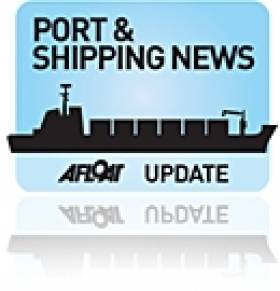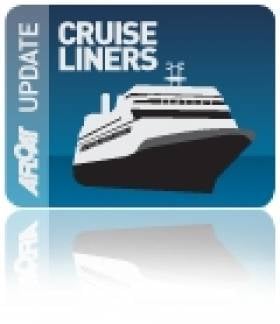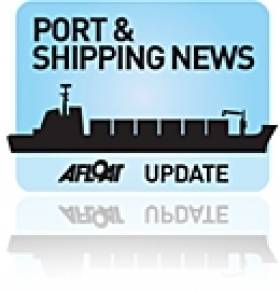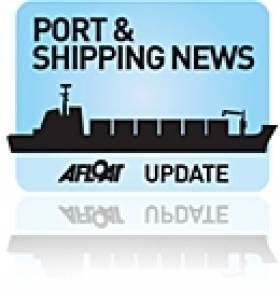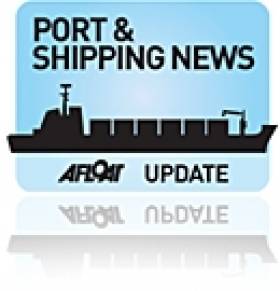Displaying items by tag: Dun Laoghaire Harbour
#ShippingReview – Over the last fortnight, Jehan Ashmore has reported from the shipping scene, where Minister for Transport Leo Varadkar, launched the National Ports Policy which is to radically overhaul commercial ports and the transfer of 'regional' ports to local authorities.
Among the proposed regional ports is Dun Laoghaire, where the harbour which is in the middle of the town is expected to focus on tourism, cruise liners and marine leisure activity.
In regards to larger strategic ports, (noting Port of Cork development update) they are charged with leading the response to national capacity requirements, something that is long overdue because port capacity has not been matching growth in traffic for either unitised and non–unitised cargo.
The policy follows the launch of a 30–year masterplan for Dublin Port Company over a year ago and the launch of the Shannon Estuary masterplan announced in February.
Responding to the National Ports Policy, the Irish Ports Association (IPA) which is the representative body for the Irish ports sector and an affiliate of IBEC welcomed the publication which sets out the policy framework for the future development of the sector.
Amidst snow flurries and gusts up to 34 knots, the cargoship Blue Tune departed Dun Laoghaire Harbour having discharged the final round of fermentation tanks bound for Guinness's St. James's Gate Brewery in central Dublin.
The Antigua and Bermuda flagged vessel, was the third such ship to dock in Dun Laoghaire Harbour since mid-February and the return of cargo ships marks a trade not seen in the port for more than two decades.
#CruiseShips- A mini-luxury cruiseship Sea Explorer docked in Dun Laoghaire Harbour today, fortunately without passengers on board, as a very unseasonable Dublin Bay was battered by a heavy snow squall, writes Jehan Ashmore.
As the Sea Explorer approached Dun Laoghaire Harbour, the pilot cutter 'Liffey' which set out from Dublin Port came alongside to transfer a pilot aboard the 4,200 tonne vessel which was arriving on a passage from Cadiz.
Sea Explorer which has a passenger capacity for 116 passengers is to remain moored in the harbour albeit in a 'lay-up' mode in advance to taking up a European season with cruises starting in June from a temporary 'homeport'.
It is the norm for cruiseships to reposition between seasons and operating regions around the world, such as the Caribbean and Mediterranean and relocate to a designated homeport.
As previously reported on Afloat.ie, Dun Laoghaire Harbour is expected to receive up to 14 cruise calls this season, including the highlight call of Cunard Line's flagship liner 'QM2' on 16 May.
Also reported was yesterday's launch of the National Ports Policy where Minister for Transport, Leo Varadkar announced that Dun Laoghaire Harbour along with four other ports were classed as having 'regional significance'.
In the case of Dun Laoghaire Harbour, the development of the port is to be in line with local requirements focusing on tourism, cruise liners and marine leisure activity.
The ports are to be transferred to the control of local authorities in a move that will require legislation which may take up to 18 months to complete.
Meanwhile, Sea Explorer will be sharing the same quayside at the ferry terminal with the new Dublin Bay Cruises excursion vessel, St. Bridget.
On the adjacent berth is another vessel with a similar name to the cruiseship, that being the HSS Stena Explorer which operates the seasonal-only fast-craft ferry service to Holyhead.
Finally, the port has also been engaged in a return to cargsoships with the third batch of Guinness fermentation tanks, which were discharged from the Blue Tune on Monday. This final batch are bound for the St. James's Gate Brewery plant in Dublin.
#GuinnessTankship - The 86m cargsoship Blue Tune (2010/3,845grt) docked in Dun Laoghaire Harbour last night is undertood to have arrived with the final batch of fermentation tanks bound for the Guinness St. James Gate Brewery in central Dublin, writes Jehan Ashmore.
In heavy seas and strong south-easterly gale force winds, Blue Tune made the short passage across the bay from Dublin Port, having firstly delivered a part-cargo from Rotterdam.
Unlike the previous deliveries of the tanks to Dun Laoghaire Harbour taken on board two Dutch-flagged vessels, firstly by Myrte (2008/6,120grt) in February followed by Keizersborg (1996/6,142grt) last month, on this occasion Blue Tune is flagged under Antigua and Bermuda.
In addition Blue Tune is smaller compared to her Dutch counterparts in terms of tonnage size which would also place her as a 'coaster' compared to much larger vessels calling to Dublin Port and in this recent 'project' cargo trade to Dun Laoghaire Harbour.
As with the other Guinness related cargo-calls, Blue Tune berthed at the former 'mail' boat at Carlisle Pier, where six stainless steel fermentation tanks are due to be unloaded within the next few days.
Likewise forward tank transportation from Dun Laoghaire to the brewery which is undergoing a major €153m upgrade, is to be undertaken by road convoy and expected to be carried out in a night-time operation.
Second Round of Guinness Tanks Arrive
#GuinnessTanks – Another shipment of Guinness fermentation tanks arrived into Dun Laoghaire Harbour, where Sunday strollers watched the cargoship's arrival, from the length of the East Pier, writes Jehan Ashmore.
On this occasion, cargoship Keizersborg (1996/6,142grt) operated by Dutch owners Wagonborg Shipping, berthed at Carlisle Pier. This is the second delivery of the 'project' cargo, with another batch due of the stainless steel cylinders, each weighing 30 tons.
They are bound for St. James's Gate Brewery, where the plant is undergoing a major upgrade costing €153m.
As previously reported, the first shipment was transported on board Myrte (2008/6,120grt) which too had sailed directly from the same Dutch port.
Also in port was the HSS Stena Explorer, which after the cargoship's docking, departed for Holyhead, so to complete the return leg of the daily operated single round-trip service.
Again ‘Tank’ Goodness for Guinness
#GuinnessTanks – More than a week after cargoship Myrte docked in Dun Laoghaire Harbour, the massive fermentation tanks were yesterday transported in a nighttime convoy to the Guinness St. James's Gate Brewery in Dublin, writes Jehan Ashmore.
Another shipment is scheduled to arrive in the harbour towards the end of this weekend and also from Rotterdam. On this occasion, cargoship Keizersborg (1996/6,142grt) operated by Dutch owners Wagonborg Shipping, will be bringing in the second of three batches of the gleaming stainless steel cylinders.
Each of the 30 ton cylinders measure 22m long x 6.6m wide and 5.4m in height and some of them are capable of holding just under 1m pints!
As for the 122m long Myrte (2008/6,120grt) she took the honour as the first commercial vessel, excluding the fastcraft HSS Stena Explorer, to call to the harbour with a consignment of cargo, not seen since the early 1990's.
During that timeframe, the Danish flagged reefer Nordland Saga (1989/2,469grt), which then was a relative newbuild, had also berthed alongside Carlisle Pier.
The vessel registered in Frederickshavn differed to the 'Guinness' project cargo carrying vessels, in that she was fitted with deck-mounted cranes. As such mobile road cranes will again be deployed in the task of unloading the giant tanks onto the Carlisle Pier, where in recent years the former mailboat ferry terminal was demolished.
Carlisle Pier to date has served at times as storage space for yachts and currently has car-parking facilities, yet there are plans to build a landmark Diaspora Centre as part of the harbour's 'master plan'.
Tanks for Guinness Arrive in Dun Laoghaire Harbour
#DunLaoghaire – Last night the Dutch-flagged Myrte (6,120 tonnes) docked in Dun Laoghaire Harbour loaded with fermentation tanks bound for Guinness, writes Jehan Ashmore.
The 10 X 30 tons fermentation tanks are to be discharged during the week and installed in Diageo's Guinness (St. James Gate) plant. The historic city-centre brewery's fermentation plant is to be refurbished as part of a major investment.
The 122m cargoship berthed alongside the former conventional ferry (mail) boat Carlisle Pier, from where the cargo will be taken by road convoy, but travelling overnight to avoid traffic and minimise disruption.
This delivery is part of a 'project' cargo as a further two shipments are scheduled, however it has been many years since cargoships have called to Dun Laoghaire Harbour.
In the late 1980's/early 90's there were relatively frequent calls undertaken by 'reefer' ships, vessels equipped with refrigeration capability carrying perishable products.
Some vessels were instead of the ro-ro design, this allowed refrigerated freight-trailers to be driven onboard the ship which berthed at the port's ferry ramp linkspan.
Ten Cruise Liners Due for Dun Laoghaire Harbour, including Queen Mary II
##cruiseliner – 10 cruise ships are expected in Dún Laoghaire in 2013 bringing an esitmated 10,000 visitors to the east coast town according to Dun Laoghaire Harbour Company. The world famous Queen Mary II will be one of the first arrivals in to Dublin Bay and Dún Laoghaire on May 16th 2013. Cunard Line's flagship Queen Mary 2 previously docked at Cobh in 2011. The 148,528 tonnes giant liner cost €549m and she is the only true 'liner' operating in the world today as she on occasions provides scheduled trans-Atlantic sailings between Southampton and New York. More on the Queen Mary II.
Take a Stroll with a Dún Laoghaire Seafront Memorial Tour
#SEAFRONT TOURS – Take in the sea-air while getting to know some historical landmarks, along Dun Laoghaire Harbour's waterfront with the Seafront Memorials Tour. The free guided tour runs every Saturday morning until the 1 September.
The tours take in all the coastal memorials to include the Queen Victoria Fountain, George IV Memorial, the mailboat R.M.S. Leinster's anchor, the Crimean War Cannon and the 1895 Lifeboat Disaster.
The tours start at 11.30 am (1 tour on each Saturday) and they take approximately 1 hour. The maximum number of people for each tour is 20 persons, noting the outdoor event is also wheelchair accessible. No pre-booking is required and places are limited so it is advisable to turn up early.
The tours are part of the 'Summer of Heritage' programme which is now in its fifth year organised by Dun Laoghaire-Rathdown County Council. For information call: (01) 254 2387 or visit: www.dlrevents.ie/heritage.html
Bad Weather Forces Tallship to Abandon Final Race Leg
#TALL SHIPS – The first of the Tall Ships has arrived, the barque STS Pogoria, an A-class tallship which berthed in Dun Loaghaire Harbour this afternoon, albeit earlier than expected due to bad weather, writes Jehan Ashmore.
The steel hulled 49m long vessel encountered bad weather in the Bay of Biscay, while taking part in the final race leg from Coruna, where on Thursday night, as previously reported on Afloat.ie, the official finishing line was off Tuskar Rock.
She made her entrance to Dublin Bay, albeit without setting sail and as she motored passed the Kish Lighthouse, she set a course for the South Burford buoy near Dalkey Island. She then headed for Dun Laoghaire rather then Dublin, from where a pilot cutter departed to board the vessel.
STS Pogoria was built for the Steel Workers Union in 1980 and her current status as 'flagship' of The Sail Training Association which is based in Gdansk, and from where she was built. She has a crew of 11 officers and a trainee crew of around 40 personnel.
Over the next few days the fleet of tallships numbering more than 40 vessels, are to arrive in Dublin Port. The next caller is expected to be the Ecuadorian Navy's sail-training ship Guayas with an ETA of 18.00hrs today. The tallship is also rigged as a barque, yet she is considerably larger, measuring nearly 80m in length and a crew complement of 112 officers and 63 trainees.
Take a stroll along Dún Laoghaire with the Seafront Memorials Tour
#SEAFRONT TOURS – Now that the bad weather that covered half of the country is behind us, the forecast at least for Dublin and next Saturday is more promising. So why not consider taking a stroll with the sea-air along the waterfront in Dun Laoghaire Harbour and learn some local history by taking a Seafront Memorials Tour. The free guided tour runs every Saturday morning until the 1 September.
The tours take in all the coastal memorials along the harbour's waterfront including the Queen Victoria Fountain, George IV Memorial, the mailboat R.M.S. Leinster's anchor, the Crimean War Cannon and the 1895 Lifeboat Disaster.
The tours start at 11.30 am (1 tour on each Saturday) and they take approximately 1 hour. The maximum number of people for each tour is 20 persons, noting the outdoor event is also wheelchair accessible. No pre-booking is required and places are limited so it is advisable to turn up early.
The tours are part of the 'Summer of Heritage' programme which is now in its fifth year organised by Dun Laoghaire-Rathdown County Council. For information call: (01) 254 2387 or visit: www.dlrevents.ie/heritage.html


























